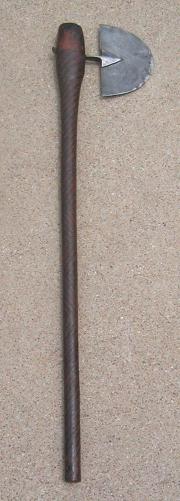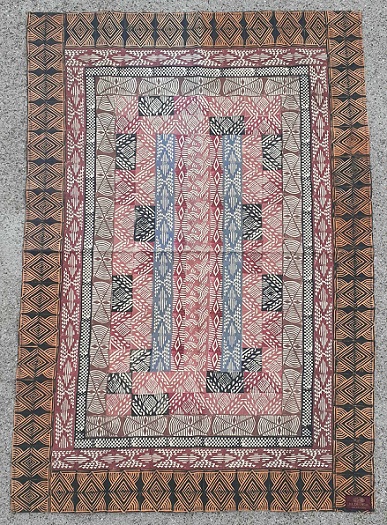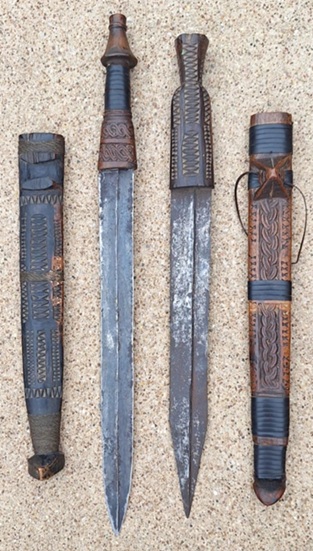Subject: warrior
Culture: Shona
Setting: Chimurenga, southern Africa 1870s-1890s
Context (Event Photos, Primary Sources, Secondary Sources, Field Notes)
* Spring 1993 p134
"The Ndbele never completely conquered the ancient Shona kingdom. In fact, as with the Maasai of Kenya and the Zulu of South Africa, the ferocity of the Ndbele raids on Shona territory were exaggerated in order to provide an excuse for expropriation, in this case the British South Africa Company's invasion of Matabeleland in 1893. The Shona were always able to retreat to fortified hill top strongholds in which they were invulnerable to attack, especially when firearms became more freely available in the 1870s."
* Schmidt 1992 p36
"When the British South Africa Company occupied Mashonaland in 1890, its fortune-seeking expedition was billed, in part, as a means of saving the weak and timorous Shona from the intrepid Ndebele. Colonial stereotyping had characterized the Ndebele as fierce and warlike, the brave if loathsome descendants of Shaka's Zulus. The Shona, on the other hand, were considered a cowardly and abject people, who for several decades previously had been terrorized and subjugated by their Ndebele neighbors. Ndebele depredations, as well as the extent of Shona territory under Ndebele control, were greatly exaggerated, laying the basis for the company's claim to all of Mashonaland. For the Shona, Pax Britannica was simply raiding and plundering under a different name. While the company effectively put an end to intra-African raiding, it confiscated cattle, conscripted labor, and collected tribute of its own.
"[...] Six years after the chartered company occupied their territory, the Shona and Ndebele people rose in revolt. ...
"The rebellion began in Matabeleland toward the end of March 1896. By the third week in June it had spread to Mashonaland, an event that took white settlers, missionaries, and company administrators completely by surprise. According to the Wesleyan Methodist missionary, Reverend Issac Shimmin, 'Nobody ever dreamt that the despised Mashonas would combine and rise.' The Jesuit superior at Chishawasha Mission, Father F. J. Richartz, wrote that the missionaries initially ignored the danger signals: 'Knowing too well the cowardly nature and history of the natives around us, we could not possibly fear their rising.' After all, Shimmin concurred, 'Were not the Matabele and the Mashona sworn enemies, and did we not set ourselves up as protectors of the latter, and therefore these poor scattered creatures could never thing of rising!'"
Guns
* Ellert 1984 p57
"The guns that were imported to Zimbabwe and exchanged for trade goods became highly prized possessions. They were useful for hunting as well as being far more effective as weapons of war. During the 19th century, the Shona made copies of these imported weapons, and these became known by the onomatopoeic names zvigidi or chigidi (from the sound of firing). These weapons were used extensively and effectively in the Chindunduma of 1896 (the first Chimurenga war)."
Axe
* Ellert 1984 p37-39
"[T]he humbwa or gano ... was much used for defence and hunting. The hunting of elephants by men armed with the gano is vividly reported upon by early Portuguese chroniclers ....
"The gano or battle axe can be divided into two separate types[;] the first is the large semi-circular bladed weapon (ruwe) where the axe head is attached to the handle (manyenza) as pictured in the illustrations. The central metal stem is often decorated with cross hatching and other designs during manufacture. Of this type, some are more sturdy than others according to the intended purpose. Gano used for elephant hunting is very strong and durable and looks practical and effective.
"The second type of gano appears to be more symbolic or decorative. Whatever the case, many of these weapons are extremely fine pieces of craftsmanship. The gano handle (manyenza) is made from carfeully selected fine grain dark or black wood. They are well balanced and often decorated with brass or copper wire. Centuries ago this would have been gold wire. The blades were often incribed with cross hatching combining with the rest to produce a truly splendid work or art. Gano of this type generally measure some 50 cm in length with the steel blade some 8 cm to 20 cm from point to point.
[...] "The large semi-circular bladed gano is normally carried slung across the right shoulder of the man while he walks in an area where he might meet trouble. Otherwise the weapon will be slung across the opposite shoulder -- of course depending upon whether he is right or left handed."





















* Spring 1993 p135
"The battleaxe, gano, ... has become, in more recently made ornamental versions, the identifying mark of the Shona spirit medium, mhondoro, whose duty is to protect the chief and his family. Ritual specialists, nganga, also carry this axe. More broadly, the gano symbolises the legitimate ownership of the land and is therefore used in modern ceremonies to denote the [Zimbabwe] nation's independence."
Club
* Ellert 1984 p53-54
"The Shona knobkerrie tsvimbo has been largely superceded by the more stylized version which is commonly found in Zimbabwe today. But during the sixteenth century, warriors of the Munhumutupa carried a good variety of weapons including a simbo which was described as a short club with a bludgeon shaped end and which was the last weapon they (the Shona soldiers) threw in battle.
"Wooden clubs are carved from a single piece of heavy grained wood. The head of the club is usually formed by a knot in the wood. The handle of the weapon can be decorated with copper or brass wire and in some cases the scrotum of a large antelope or ox is shrunk over the clubhead."
Sword
* Spring 1993 p134
"The large knives or bakatwa ... are double-edged and some examples ... are sufficiently large to be described as a short sword. The sheath or hara is made of two pieces of wood, or occasionally ivory, which are beautifully carved and bound together with wire. Ornamental sections of fine brass wire often embellish the hilt and sections of the sheath."
Dagger
* Ellert 1984 p43
"Bakatwa is the general Shona word for the wooden scabbard daggers which can be found in Zimbabwe. Although the concept of a scabbard dagger might well have been copied from coastal Arab traders who ventured into the interior many centuries ago, the particular type of dagger or knife found here has developed as uniquely Zimbabwean. The wooden scabbard (hara) comprises two separate pieces of wood bound together by brass or copper wire. The top section of the scabbard is usually richly decorated with intricate carvings of various designs. The rear section of the scabbard features a wooden belt loop to allow the wearer to strap the weapon about his waist.
"[...] The iron blade of the bakatwa (banga or chese) was beaten out from a central ridge so that one cutting edge was set slightly higher than the opposite edge. The blade was set into a wooden handle (mubato). ... Bakatwa measure an average 43 to 100 cm."
* Pitt Rivers Museum online > Bakatwa (1905.45.1)
"The bakatwa is a double-edged sword of the Shona people of Zimbabwe, used in religious ceremonies. ...
"In historical times, all Shona men carried a knife or sword of some kind, for use in self-defence and hunting. The ceremonial bakatwa can be distinguished from everyday Shona blades (known as banga) because of its double-edged form and the intricate woven brass wire decoration on the hilt. This weapon was accorded a high level of prestige in traditional Shona religious practice.
"Bakatwa were and are passed down from generation to generation in a lineage, and were used in religious rituals to symbolise the presence of the owner's ancestors, the sword's previous owners. In these rituals, the owner addressed the bakatwa as if it was the physical embodiment of his ancestors. This link between the spirits and these swords also meant that n'angas (diviner-healers) and svikiros (spirit-mediums) carried them as the insignia of their profession. Certain Shona hunters were traditionally believed to be under the spiritual influence and guidance of deceased hunters, known as shave spirits, so they also carried bakatwa as a symbol of their spirit ally."
Costume
*
"
Knife
* Ellert 1984 p44
"A smaller and simpler version of the bakatwa is the banga or simple sheath knife. This comprises a single edge blade secured in a double sided wooden scabbard virtually identical to the large bakatwa but without the fine wood carving."





